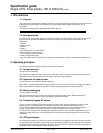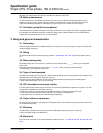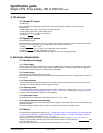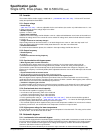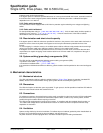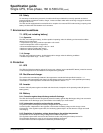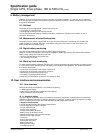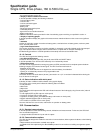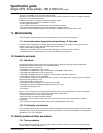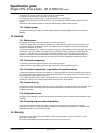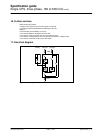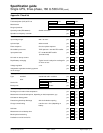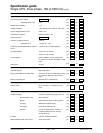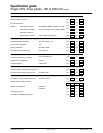
Specification guide
Single UPS, three-phase, 160 to 500 kVA
(cont.)
APC by Schneider Electric Edition - 01/2010 Single UPS spec - p.
5
5.3. Inverter
The inverter shall be sized to supply a rated load of …[160/200/250 / 300 / 400 / 500]… kVA at 0.9 PF and shall
satisfy the specifications listed below.
5.3.1. Output voltage
ω Rated voltage
…[380 / 400 / 415 / 440]… volts rms, adjustable via the user interface (see section 10), within tolerances of +/- 3%
in order to take into account voltage drops in the cables.
ω Number of phases
3 phases + neutral + earth.
ω Steady-state conditions
Variations in the rated voltage shall be limited to ± 2% for a balanced load between 0 and 100% of the rated load,
whatever the voltage level on the normal AC source and the DC voltage level, within the limits defined in sections
4.1 and 5.1.4.
ω Voltage variations for load step changes
Output voltage transients shall not exceed ± 1% of rated voltage for 0 to 100% or 100 to 0% step loads. In all
cases, the voltage shall return to within steady-state tolerances in less than 100 milliseconds.
ω Unbalanced conditions
For a load unbalance between phases, the variation in the output voltage shall be less than 1%.
5.3.2. Output frequency
ω Rated frequency
-50 or 60 Hz.
ω Variations in the free-running frequency
- ± 0.5 Hz.
5.3.3. Synchronization with bypass power
ω When bypass power is within tolerances
To enable transfer to bypass power (see conditions in section 5.4), the inverter output voltage shall be
synchronized with the bypass source voltage whenever possible. To that end, during normal operation, a
synchronization system shall automatically limit the phase deviation between the voltages to 3 degrees, if the
bypass source frequency is sufficiently stable (within adjustable tolerances of 0.5% to 8% with respect to the rated
frequency).
ω Synchronization with an external source
It shall be possible to synchronize with all types of external source.
ω Autonomous operation following loss of synchronization with bypass power
When the bypass source frequency deviates beyond these limits, the inverter shall switch over to free-running
mode with internal synchronization, regulating its own frequency to within ± 0.02 Hz. When bypass power returns to
within tolerances, the inverter shall automatically resynchronize.
ω Variation in frequency per unit time
To avoid transmitting to the inverter any excessive frequency variations on the bypass AC source when it is within
tolerances, inverter frequency variations per unit time (dF/dt) shall be limited to 1 Hz/s or 2 Hz/s (user defined).
5.3.4. Overload and short-circuit capacity
The UPS shall be capable of supplying for at least:
ω 10 minutes a load representing 125% of the rated load
ω 1 minutes a load representing 135 % of the rated load
ω 30 second a load representing 150% of the rated load.
ω For the specified power rating of …[ 160 / 200 /250 / 300 / 400 / 500 ]… kVA, the inverter shall be capable of
current limiting to a peak capacity of ... [290 / 235 / 277 / 230 / 234 / 245% ] ... for 150 ms to allow highly disturbed
transient operating states without transferring the load to the bypass.
ω The overload capacity shall be capable of taking into account temperature conditions for more than ten minutes,
by allowing a continuous, 10% overload when the temperature is less than or equal to 20°C.
5.3.5. Higher power ratings for lower temperatures
It shall be possible to increase the power rating when the temperature is less than 35°C. The rating can be raised
by +3% for 30°C, +5% for 25°C and +8% for 20°C.
5.4. Automatic bypass
5.4.1. Load transfer to the automatic bypass
The UPS shall be equipped with an automatic bypass comprising a static switch. Instantaneous transfer of the load
from the inverter to bypass power and back shall take place without a break or disturbance in the supply of power
to the load, on the condition that the bypass source voltage and frequency are within the tolerances specified in
section 4.2 and that the inverter is synchronized.
Transfer shall take place automatically in the event of a major overload or an internal inverter fault. Manually




